RACHAEL BLASBALG
It’s getting harder to find what you want at the grocery store. Inflation is driving up prices. And there is no end in sight. Starting a seedbank now will help you prepare for the upcoming food crisis.
A seedbank will ensure that you have what’s necessary on hand to feed your family when SHTF.
So what are you waiting for? Let’s get started.
What Is A Seedbank?
A seedbank is a collection of many different varieties of seeds properly stored to ensure the highest germination rate.
They exist both on a large scale, run by governments and trusts, as well as on a smaller community and family-scale.
Currently, you may simply supplement your diet with food from your garden.
But during a food shortage, you may find yourself forced to consume all your food from your land. In order to do this, you will need a wide selection of seeds to plant.
⇒ How To Build A Hidden Food Growing Fence In Your Backyard
You will want traditional garden staples like tomatoes and cucumbers in your seedbank and a wide selection of grains and medicinal plants.
If you keep animals on your land, don’t forget to consider what their feed needs are as well.
How To Best Store Your Seeds
You want to store your seeds in a way that will protect them until they are ready to plant. The best way to store them is in air-tight containers.
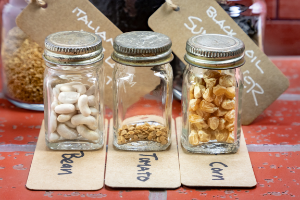
Glass jars with rubber seals are an excellent way to keep seeds safe. The jar protects them from animals, mold, and other factors that can decrease their germination rate.
I’ve also had great luck with seeds stored in mylar bags. These bags can be a good option if you are short on space.
Government run seed banks are often located deep underground in caves. So if you have a root cellar or a basement, that can be a good option if it isn’t too damp.
Dampness is very bad for seed storage. One way to help protect your seeds from humidity is to use silica desiccation packs or even rice to help absorb excess moisture.
Where To Get Your Seeds
The best place to get seeds for your seedbank is from plants already growing in your garden. Saving seed, rather than repurchasing it every season, used to be traditional.
But hybridized and GMO seeds do not produce seeds that will be viable in a second season. So farmers and gardeners have become accustomed to buying new seeds every year.
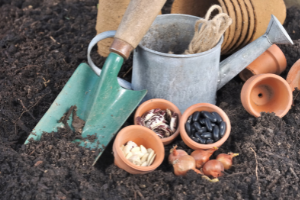
If you plant heirloom varieties rather than GMO or hybridized seeds, then you will be able to break the cycle.
Every season when your fruits or vegetables are ripe, you set a certain part of your harvest for seed. To collect your seeds choose your heartiest, most fruitful, best tasting plants.
If you don’t already have a garden, you can either ask a friend or neighbor who is growing vegetables to share their seeds.
Or you can purchase seeds either from a local nursery or online. Make sure that you purchase heirloom seeds.
⇒ Buy Here A Kit That Has Everything You Need To Start Your Medicinal Herb Garden
This will ensure that you can harvest viable seeds each generation.
Essential Seeds For Your Seedbank
It’s challenging to compile a complete list of every plant you need in your seedbank. Every family has different dietary needs, and different plants grow in different heartiness zones.
However, What you see here is a great place to get started. If you see something missing from my list, by all means, add it!
When building a seedbank, the more seeds and the more varieties you are able to obtain, the better off you will be.
Vegetables
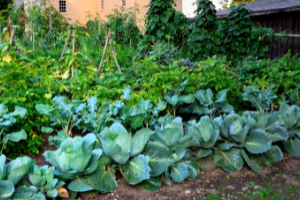 Growing your own vegetables is an easy way to survive a food shortage. Our grandparents knew that when they grew their Victory Gardens. By storing your own seeds, you can always be ready to start that garden. When planning your seedbank, consider which vegetables your family will eat, as well as what will grow best in your area.
Growing your own vegetables is an easy way to survive a food shortage. Our grandparents knew that when they grew their Victory Gardens. By storing your own seeds, you can always be ready to start that garden. When planning your seedbank, consider which vegetables your family will eat, as well as what will grow best in your area.
Also, look to include vegetables that will ripen throughout the year.
Related: How To Preserve Your Vegetables Using Sand
Consider what grows in your area in spring, summer, fall, and winter. Cabbages, for example, can survive pretty cold temperatures.
Onions: Start to plant in early spring. You can begin harvesting as soon as the bulbs reach a usable size.
Garlic: Garlic is best planted in the fall. You then harvest the following summer.
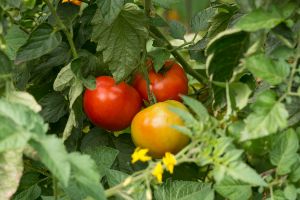 Tomatoes: You can seed tomatoes directly in your garden.
Tomatoes: You can seed tomatoes directly in your garden.
Just wait until all danger of night frosts has passed.
Plant 3-5 plants for each family member, more if you want to can or preserve your tomatoes for winter.
Cucumbers: Wait until at least two weeks after the last frost before you plant your cucumber seeds in the garden.
For a continual harvest, plant more cucumbers every two weeks. You can begin harvesting cucumber in as few as six weeks.
Peppers: Peppers have a long growing season, so you may want to start your seeds indoors for an earlier harvest. However, you can expect your pepper plants to continue producing right up until the first frost.
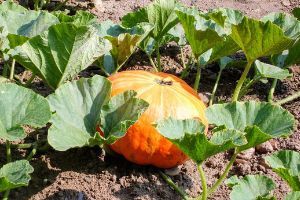 Pumpkins: You want to wait until it’s warm enough outside before planting your pumpkin seeds.
Pumpkins: You want to wait until it’s warm enough outside before planting your pumpkin seeds.
You shouldn’t plant them before late May.
While it may take a while, pumpkins provide an amazing harvest in the fall.
Eggplant: Start your eggplant seeds inside, and they will be ready to transplant after the frost danger has passed. Then they will be ready to harvest around midsummer.
Related: How to Can Eggplant with Pepper for a Long Time Storage
Cabbage: If you want to harvest cabbages in the summer, you will want to start the seeds indoors about two months before your last frost.
Otherwise, you can sew seeds directly in your garden around midsummer for a fall harvest.
Peas: Peas don’t like heat so plant them either in early spring or late fall. Or, if you want two harvests, save seeds from your spring harvest to plant again about six weeks before your first fall frost.
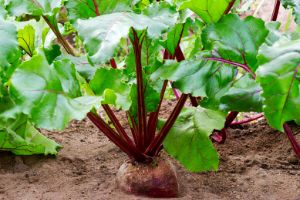 Beets: Beets are a quick, healthy crop.
Beets: Beets are a quick, healthy crop.
They are cold tolerant, so you can plant them early in the spring.
You can harvest after just thirty days after you plant them. This is a dual purpose plant, so don’t forget to eat the delicious greens.
Spinach: For an early spring spinach harvest, you can sew seeds in late fall. Then protect the area with heavy mulch.
You can also plant spinach seeds in late summer and harvest them as the weather cools off in the fall.
Lettuce: Lettuce grows best in cooler seasons like spring and fall, though you can get summer harvests in cooler regions. You can plant seeds every two to three weeks to ensure you always have salad.
Radish: Radish is a fast growing crop that is a great companion to carrots. You can sew the seeds for both crops together. The radishes will be ready to harvest just as your carrot seeds start to sprout.
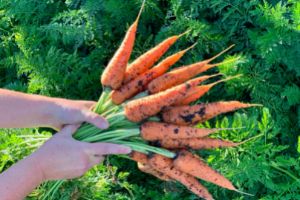 Carrots: Carrots are another vegetable that you can plant early in spring.
Carrots: Carrots are another vegetable that you can plant early in spring.
However, they take longer to mature than beets or radishes.
Expect at least two weeks before you see signs of growth. If you wait until late summer, you can harvest them in fall.
Zucchini: You should wait until all danger of frost has passed before planting zucchini seeds in the garden. Each plant will be very prolific, so just a few plants are usually enough for a family.
Beans: There are many different types of beans out there.
But whether you are planting pole beans or bush beans, you still need to wait until the danger of the last frost has passed.
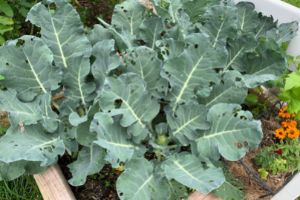 Broccoli: In cooler areas, it’s best to start your seeds indoors before the last frost to ensure your broccoli matures before it is too hot.
Broccoli: In cooler areas, it’s best to start your seeds indoors before the last frost to ensure your broccoli matures before it is too hot.
If you live in a warmer climate, you can direct sew in your garden. Your broccoli will bolt from the summer heat if you don’t plant it early enough.
Fruits
Fruit trees can take a long time to bear fruit, so as the saying goes, “the best time to plant a tree was ten years ago.”
However, it’s always beneficial to have a variety of fruit seeds to plant to start an orchard or just a couple of trees for the family.
Softer fruits will start to mature more rapidly than harder fruits so take that into consideration. Also don’t forget about annuals, like strawberries.
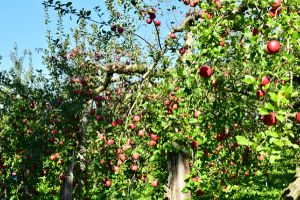 Strawberries
Strawberries- Mulberry
- Peach
- Apple
- Pear
- Citrus
Grain
You will probably want to grow at least one type of grain in your garden. What you choose will be based on your location and how much space you have.
Corn is a great option as it is easier to harvest than wheat if you are not familiar with processing your own grains.
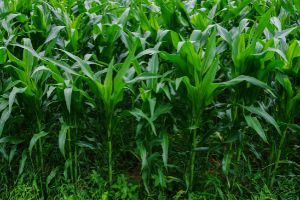 Corn
Corn- Rice
- Wheat
- Sorghum
- Barley
- Oats
Herbs
Herb seeds are an essential part of a survival seedbank. Not only do herbs help liven up your meals, but often they have medicinal uses as well.
A kitchen herb garden can help you survive lean times. There are some of the herbs you should have in your garden: Chamomile, Chicory, Oregano, Yarrow, Marjoram, Feverfew, Rosemary, Thyme, Calendula, Peppermint, Meadowsweet.
Keeping and maintaining a seedbank can help ensure your family’s survival during a food crisis. And really, it’s not difficult to do.
Luckily seeds take up very little room, so that you can store a lot of them in a small space. And if you are already growing a garden, it’s one more step in your harvest.
Think not only of the money you save by not buying seed but the freedom you obtain by being able to feed your family.

No comments:
Post a Comment